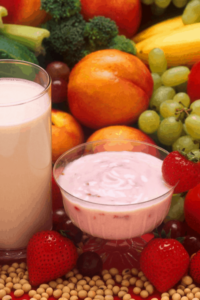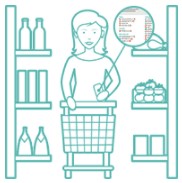With so much “mis-information” out there, especially about foods, we wanted to help clear the air a bit about seemingly healthy foods that are actually foods to avoid! So we asked Cassandra Suarez, one of our team registered dietitians, to do a special post on a hot topic related to nutrition. She knew just the thing: healthy food myths, meaning food that people commonly think are good for them, but really are anything but. Listed below are Cassandra’s top six food myths that she hears all the time from her time as a practicing registered dietitian. So take it away Cassandra! And here’s to your health everyone!

Cassandra Suarez, Registered Dietitian
6 Seemingly Healthy Foods That Can Be Foods to Avoid
Gluten Free Food Products
Gluten-free products are all the rage these days, whether you need to be gluten-free or not. Although some gluten-free products are nutritious, by no means does a “gluten-free” label equate to the food being healthy. At The Dinner Daily, we do offer menus for gluten-free diets through our customization options, but our gluten-free meals focus on whole foods, not processed gluten free products. And they are intended primarily for people who have a gluten intolerance.
The problem with gluten-free food occurs when the item is overly processed with many ingredients. This almost always means it’s not as healthy as other whole foods you could be eating. Keep in mind this is true of both gluten-free items and foods that contain gluten.
Also, remember that gluten-free cookies and cakes are still cookies and cakes. In fact, many gluten-free products are less healthy than their gluten counterparts (unless you have Celiac disease or have a gluten intolerance). This is because they often substitute whole grains for lower nutrient quality ingredients and add more sugar to preserve taste.
My Tip: The best gluten-free foods are the ones naturally gluten-free; think fresh fruits, vegetables, fish, meats, nuts, and seeds!
Low-Fat/Fat-Free Foods

Don’t fall into the fat-free trap. Just because something is fat-free doesn’t make it healthy. In fact, many flavored yogurts have upwards of 20 grams of sugar in that tiny 6-ounce serving!
The low-fat claim on food labels can almost be synonymous with “high sugar,” as food industries often replace fat with sugar in order to preserve the taste – but not your waistline.
Fortunately, the low-fat craze is finally starting to end. The 2015 U.S. Dietary Guidelines have lifted their restrictions on total fat and cholesterol in the diet. It’s refined carbs and sugar, not saturated fats, that drive up cholesterol and the risk for heart disease.
My Tip: Pay attention to the food label and not the food claim. Select packaged items where grams of protein plus grams of fiber are greater than grams of sugar whenever possible.
Vegetable Oils
It may be time to replace the oils you use for cooking in your kitchen. Industrial seed oils, also known as vegetable oils, are one way the food industry turns a profit from what would otherwise be wasted. Today, subsidies for corn and soybeans make the supply of these foods much greater than the demand, and oil is one way to turn this otherwise-unprofitable surplus into “food.” To make matters worse, often these oils are chemically bleached, deodorized, and dyed yellow. Always buy oils stored in dark bottles to prevent damage from light exposure.
Vegetable oils, including corn, soybean, sunflower, canola, cottonseed, and safflower oils, are all high in omega-6 fats, which can cause inflammation in the body and are less stable with heat than other oils such as ghee, coconut oil, or avocado oil.
Vegetable oils are very prone to spoiling at high temperatures and often go through a high heat refining process in manufacturing, meaning that these oils are often rancid before hitting the grocery store shelf.
Cooking Oil Heating Guidelines: Substitute your vegetable oils for ghee (up to 485°F), coconut oil (up to 450°F), and avocado oil (up to 500°F) for medium-heat or lower cooking and extra virgin olive oil for low-temperature cooking (up to 320°F) or for dressing food.
Granola
Is granola really good for you? Granola seems so healthy, with rolled oats, nuts, and dried fruits. What is misleading, though, is how much sugar and extra calories lurk in granola. A bowl of granola can easily contain 500 or more calories—and that’s without the milk! Be wary of granola with added sugar, dried fruit, and many ingredients.
My Tip: Indulge smartly by choosing high-fiber varieties with low sugar. Look for granola with at least 3 grams of fiber per serving and remember that grams of protein plus grams of fiber should be greater than grams of sugar. Also, stick to the recommended portion size on the label.
Dried Fruit
While dried fruit does contain fiber, vitamins, and minerals, many food manufacturers add sulfur and sugar to make it more shelf stable. While you can buy unsulfured and unsweetened varieties in health food stores, the fruit (and the sugar it contains) is in a concentrated state, making it way too easy to eat a whole fruit basket worth of fruit instead of a typical serving. This will increase your blood sugar levels and hurt any weight loss goals.
My tip: Why not just eat fresh fruit instead? It’s much more filling and has fewer calories per serving!
Veggie Chips
Looking at the bag, these might seem super healthy. But did you catch the first item on the ingredient list? Usually, it’s corn or potatoes – not tomatoes or spinach! In fact, the pieces of actual veggies in veggie chips are so small and so processed that most of the nutrition from them is gone. This is why the food industry lists the vegetables as powders and put them near the end of the ingredient list. Also, the types of oils used are most likely canola or another industrial seed or vegetable oils.
My Tip: You’re better off eating raw veggies instead or making your own nutritious kale or beet chips.
Healthy foods or Foods to Avoid?
The bottom line to all of this is that just because a company claims a food to be “healthy”, take the time to read the labels and apply some of my tips above to determine if they really are. You might just find they are actually foods to avoid if you want to truly achieve your nutritional goals.
About Cassandra:
Cassandra Suarez, MS, RDN, LDN, cPT is a Registered Dietitian and Nutrition Communication Specialist. Her specialties include both individual and corporate wellness. She completed her dietetics training at Tufts Medical Center and has a Master of Science in Nutrition Communication from the Tufts Friedman School of Nutrition Science & Policy.
Creating a Healthy Meal Plan
The Dinner Daily creates weeknight meal plans and recipes that keep the health of your family in mind. Yes, our meal plans help save money and get your organized,  making dinnertime much easier.
making dinnertime much easier.
But we always are on the lookout for the best ways to replace unhealthy ingredients with whole ingredients and provide you with a nutritious, well-rounded meal that aligns with your diet needs and goals.







